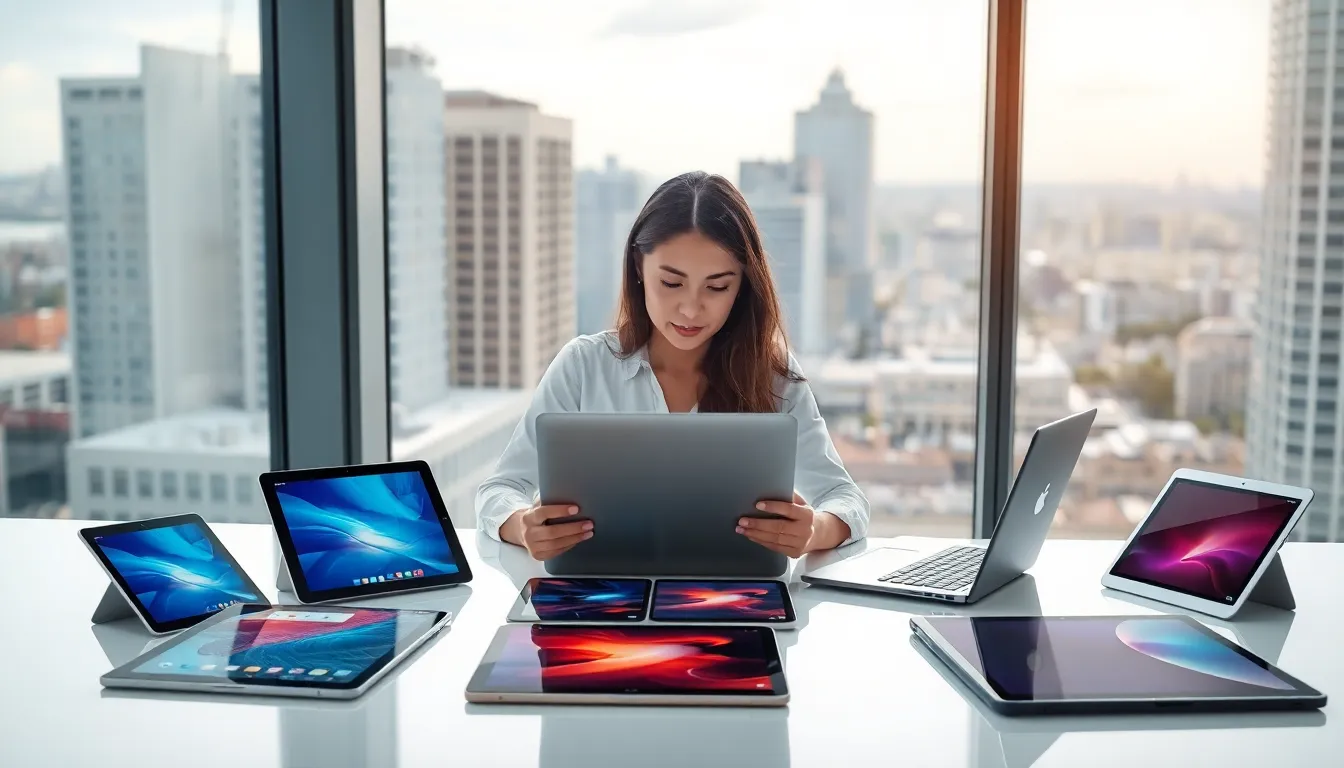Tablets have transformed the way people consume content, work, and even connect with each other. With their sleek designs and versatile functionalities, it’s no wonder they’ve become a staple in our daily lives. But with so many options and features, it’s easy to feel overwhelmed. What’s the difference between a tablet and a laptop? Which one’s perfect for binge-watching cat videos or tackling that work presentation?
Table of Contents
ToggleGeneral Questions About Tablets
Tablets serve as versatile devices that combine the portability of smartphones with the functionality of laptops. Understanding how they operate and their unique features enhances the user experience.
What Is a Tablet?
A tablet is a portable touchscreen computer, typically larger than a smartphone but smaller than a laptop. These devices operate on mobile operating systems such as iOS or Android. They often come with built-in cameras and speakers, catering to various multimedia needs. Tablets possess app support, allowing users to run various applications for work, entertainment, and education. Battery life generally spans 8 to 12 hours, enabling all-day use without constant recharging.
How Do Tablets Work?
Tablets function through a combination of hardware and software. Touchscreens serve as the primary input method, allowing users to interact directly with the display. Most tablets rely on processors similar to those found in smartphones, providing adequate power for applications. Operating systems manage hardware resources and ensure apps run smoothly. Wireless connectivity through Wi-Fi or cellular networks enables access to the internet and cloud-based services. Additionally, some tablets support styluses for precise input, enhancing tasks like drawing or note-taking.
Tablet Buying Guide

Buying a tablet involves understanding key factors that align with personal needs and preferences. Consider whether the primary use involves entertainment, work, or education.
Factors to Consider When Buying a Tablet
Operating system choices, including iOS, Android, and Windows, matter significantly. Each operating system offers unique app ecosystems. Display size and resolution also impact the viewing experience; larger screens enhance movie-watching while higher resolutions improve image clarity. Battery life capabilities vary among models, so checking specifications ensures all-day functionality. Storage options—ranging from 32 GB to 512 GB—should meet the user’s storage needs for apps and media. Lastly, connectivity features such as Wi-Fi and cellular options provide flexibility for internet access.
Best Tablets for Different Needs
Finding the right tablet often depends on specific requirements. For students, iPad offers a balance of portability and functionality with a diverse app library. Professionals benefit from Microsoft Surface Pro, which combines tablet convenience with laptop power. Amazon Fire tablets serve as budget-friendly options for casual users and avid readers, offering access to books and streaming services. Creatives often prefer Samsung Galaxy Tab S series for its high-resolution screen and stylus support, making it suitable for design work. Ultimately, choosing the best tablet hinges on intended usage and personal preferences.
Common Tablet Issues
Various common tablet issues arise during everyday use, affecting user experience. Addressing these problems often improves performance and longevity.
Troubleshooting Common Problems
Frequent screen freezes can disrupt tasks. Restarting the tablet usually resolves this issue. Slow performance often occurs due to overloaded memory. Clearing unused apps or files helps enhance speed. Connectivity problems may arise with Wi-Fi or Bluetooth. Checking settings or resetting the connection often solves these difficulties. Battery drain can happen unexpectedly. Adjusting settings like brightness or turning off location services may extend usage time.
Battery Life and Maintenance
Battery life plays a significant role in tablet functionality. Regular charging habits can affect battery health over time. Keeping the device updated ensures optimal performance and security. Removing unnecessary apps can improve energy efficiency. Cleaning the charging port removes dust or debris that hinders charging. Utilizing battery saver modes increases longevity during critical tasks. Regularly restarting the tablet resets memory and improves overall speed.
Tablet Accessories
Tablets benefit significantly from various accessories that improve functionality and user experience. Essential accessories can enhance productivity, comfort, and convenience.
Essential Accessories for Tablets
Stylus pens provide precision for drawing or note-taking. Keyboard cases transform tablets into mini laptops, making typing easier. Screen protectors safeguard displays from scratches and damage. Charging docks keep devices powered while offering a stable platform. Bluetooth speakers enhance audio quality for streaming or gaming. These accessories ensure users maximize their tablet capabilities.
How Accessories Enhance Tablet Usage
Accessories improve overall usability and convenience. Using a stylus allows for more intricate designs and detailed notes. A keyboard enhances typing speed and efficiency, particularly in professional settings. Screen protectors prevent wear, maintaining display clarity. Docks offer hands-free charging, allowing for uninterrupted use during tasks. Enhanced audio from speakers elevates entertainment experiences. Accessories transform tablets into versatile tools for work and leisure.
Tablets have firmly established themselves as essential tools in modern life. Their ability to blend portability with functionality makes them ideal for various tasks from entertainment to professional work. With numerous options available understanding personal needs is crucial for making the right choice.
Addressing common issues and knowing how to maintain battery life can significantly enhance the user experience. Additionally investing in accessories can transform a tablet into a powerful device tailored to individual preferences. By considering these factors users can fully leverage the potential of their tablets for both productivity and leisure.




